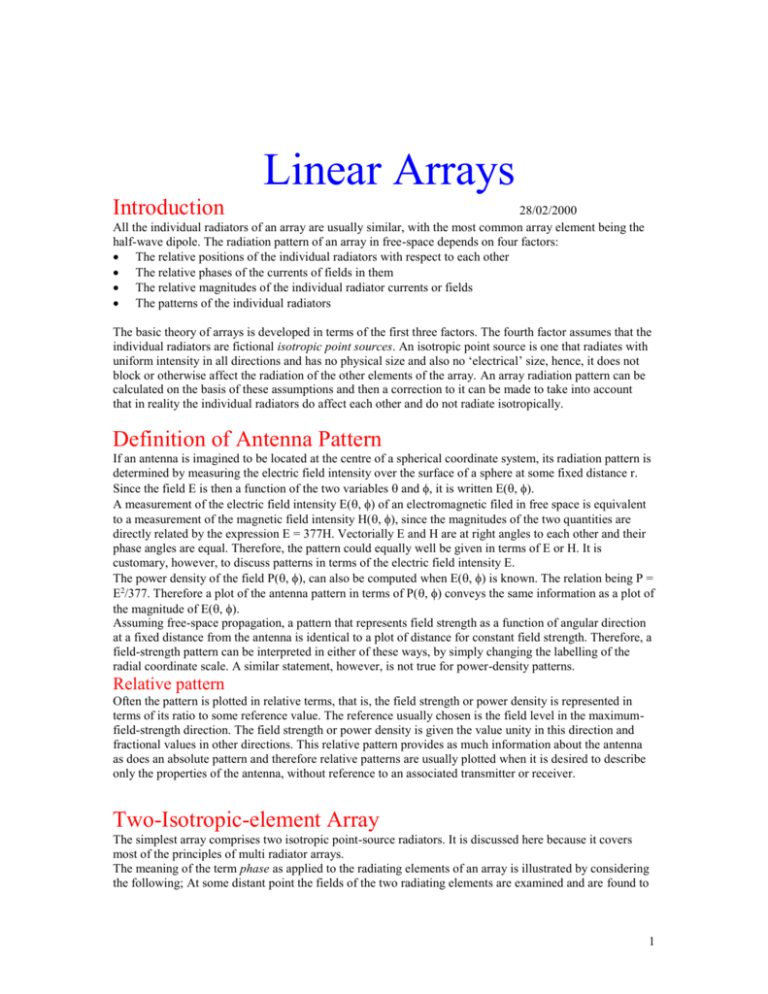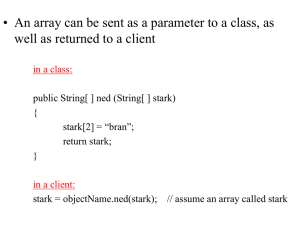Linear Arrays
advertisement

Linear Arrays Introduction 28/02/2000 All the individual radiators of an array are usually similar, with the most common array element being the half-wave dipole. The radiation pattern of an array in free-space depends on four factors: The relative positions of the individual radiators with respect to each other The relative phases of the currents of fields in them The relative magnitudes of the individual radiator currents or fields The patterns of the individual radiators The basic theory of arrays is developed in terms of the first three factors. The fourth factor assumes that the individual radiators are fictional isotropic point sources. An isotropic point source is one that radiates with uniform intensity in all directions and has no physical size and also no ‘electrical’ size, hence, it does not block or otherwise affect the radiation of the other elements of the array. An array radiation pattern can be calculated on the basis of these assumptions and then a correction to it can be made to take into account that in reality the individual radiators do affect each other and do not radiate isotropically. Definition of Antenna Pattern If an antenna is imagined to be located at the centre of a spherical coordinate system, its radiation pattern is determined by measuring the electric field intensity over the surface of a sphere at some fixed distance r. Since the field E is then a function of the two variables and , it is written E(, ). A measurement of the electric field intensity E(, ) of an electromagnetic filed in free space is equivalent to a measurement of the magnetic field intensity H(, ), since the magnitudes of the two quantities are directly related by the expression E = 377H. Vectorially E and H are at right angles to each other and their phase angles are equal. Therefore, the pattern could equally well be given in terms of E or H. It is customary, however, to discuss patterns in terms of the electric field intensity E. The power density of the field P(, ), can also be computed when E(, ) is known. The relation being P = E2/377. Therefore a plot of the antenna pattern in terms of P(, ) conveys the same information as a plot of the magnitude of E(, ). Assuming free-space propagation, a pattern that represents field strength as a function of angular direction at a fixed distance from the antenna is identical to a plot of distance for constant field strength. Therefore, a field-strength pattern can be interpreted in either of these ways, by simply changing the labelling of the radial coordinate scale. A similar statement, however, is not true for power-density patterns. Relative pattern Often the pattern is plotted in relative terms, that is, the field strength or power density is represented in terms of its ratio to some reference value. The reference usually chosen is the field level in the maximumfield-strength direction. The field strength or power density is given the value unity in this direction and fractional values in other directions. This relative pattern provides as much information about the antenna as does an absolute pattern and therefore relative patterns are usually plotted when it is desired to describe only the properties of the antenna, without reference to an associated transmitter or receiver. Two-Isotropic-element Array The simplest array comprises two isotropic point-source radiators. It is discussed here because it covers most of the principles of multi radiator arrays. The meaning of the term phase as applied to the radiating elements of an array is illustrated by considering the following; At some distant point the fields of the two radiating elements are examined and are found to 1 be in phase with each other. If then the phase of the current in Radiator 2 is changed by an amount radians and the phase of the current in Radiator 1 is left unchanged, it will be observed that the two fields at the distant point are now out-of-phase by the amount radians. The phase of a radiating element in an array is always discussed in relation to the phases of the other elements. If the phases of the two radiators in a two-element array are changed by the same amount, the array pattern is unaffected, but changing the phases between the two elements affects the way that the individual fields of the tow radiators add up at a specified distant point. Figure 1 shows the significant geometry of a two-element isotropic-point-source array. Figure 1 – Array of two isotropic sources The coordinates of P are ‘r’ and are two coordinates of the spherical coordinate system. The third spherical coordinate , is not shown because only a plane in which is constant is being considered here, namely, the xy-plane in which 2 radians. The point P is the field point, that is, any point in space where the field is to be calculated. Hence, an expression of the field strength a P applies to all points and thus defines the radiation pattern of the array. Calculation of the field due to the array at an arbitrary point P is the basic problem of array theory. Because the distances r 1 and r2 are much larger than the distance d, the amplitudes of the separate fields of the two radiators at point P will be very nearly the same due to the large attenuation that the radiation from each radiator experiences. On the other hand, the relative phases of the two fields at P arising from the two radiators will be dependent on , where r2 r1 , as shown in Figure 2. Figure 2 – Two-element array geometry 2 The resulting phase difference of the fields due to is equal to 2 radians, where Radiator 1 or R1 is taken to be the reference phase. To this difference must be added the initial phase difference , between the two radiators themselves. The total phase difference of the two fields at P is then given by 2 (1) The resultant field at P is the superposition of two fields of equal amplitude, Eo, and phase difference . If two fields of the same amplitude Eo, are considered as two vectors separated by an angle , then the resultant field E, can be found by using the cosine rule, as E 2 Eo cos 2 (2) This is the first step toward finding the radiation pattern of the array, which is an expression of E as a function of , the angle of the direction of P from the centre of the array. To obtain the radiation pattern, it is necessary to express in terms of . From figure 2, d sin (3) On substituting equation 3 into equation 1 and the resultant back into equation 2, gives the equation for the field E() at P. d sin E 2 Eo cos 2 (4) Equation 4 is the expression for the field at P as a function of the angle that the direction of P makes with the line perpendicular to the line of the array. Equation 4 gives the shape of the pattern in the xy-plane or 2 plane. The absolute-value brackets are used to indicate that the field intensity being calculated is proportional to the amplitude or to the rms value and is therefore a positive number, although the expression inside the brackets may be signed. In order to obtain the relative pattern, for which the field strength in the maximum-intensity direction has the value unity, equation 4 must be divided by the maximum value of E, which is usually, but not always 2E0. Three-dimensional pattern Equation 4 describes the array pattern in the xy-plane, in which the angle of a three-dimensional coordinate system is constant ( 2 ). Because the angle is constant it does not appear in equation 4. The three-dimensional pattern is obtained by revolving the xy-pattern about the y-axis, which is the line of the array. This is possible as the xy-pattern is identical in shape and size at any value of rotation in the yzplane. The pattern in the yz-plane is expressed as a function of the angle instead of the angle . In other planes, both angles are involved. The expression for the complete three-dimensional pattern is given by, d sin sin E , 2 Eo cos 2 (4a) Parallel dipole two-element array The pattern defined by equation 4 can be plotted as a function of the angle for different values of the parameters d and . (Note that a parameter is defined in mathematics as a quantity that can vary but is held constant in a particular problem so that the effect of some other variable may be studied, uncontaminated by any variation of the parameter.) Although the various resulting patterns obtained are for an array of isotropic elements, they also represent the patterns of an array of two dipoles in the plane perpendicular to their axis. Providing that the dipoles are parallel to each other and perpendicular to the line joining their centres (line of the array), as shown in Figure 3. This diagram may be thought of as the horizontal-plane 3 patterns of a pair of vertical dipoles or monopoles separated by a distance d and with currents having a phase difference . Figure 3 – Geometrical positioning of pattern for two dipoles It should be noted that when the two elements are in phase ( = 0), the radiation is always maximum in the direction perpendicular to the line joining the elements, that is in the x-direction in Figure 3 above. That is, because the distances from the elements to the field point P are equal in that direction ( = 0), the phase difference due to path difference is zero also; hence the total phase difference of the superimposed fields is = 0. Consequently, the fields add directly and the maximum possible resultant field is obtained. When = 0 and the pattern maximum is in the direction perpendicular to the array line, as shown in Figure 3, the antenna is called a broadside array. For certain conditions the resultant field in some directions is zero, that is when the sum of the radiator phase difference , and the phase difference due to path difference 2 is an odd integral multiple of radians. The fields of the individual radiators are in this case, of equal amplitude and opposite phase, so they cancel. This occurs, for example, when = 0 and d = /2, in the = 90 and 270 directions, since in these directions the field phase-difference is 180 degrees, whereas the phase difference due to radiator phase difference is zero. The same result occurs when the 180 degrees net phase difference is due to a combination of path difference and radiator phase difference. These directions of zero intensity in a pattern are called nulls. Certain combinations of d and result in maximum radiation in the direction of the line joining the array elements. The array is then said to be operating as an endfire array. The radiation of an endfire array may be either bidirectional or unidirectional. A bidirectional array is where the radiation lobes are in both directions along the line of the array. Whereas, a unidirectional array has a lobe in one direction and a null in the opposite direction. Multi-element Uniform Linear Arrays When more than two elements are used in an array, the principle of calculating the pattern (from which in turn the beamwidth and directive gain can be computed) is the same as for a two-element array. Except that the fields of all the elements must be superposed at the field point. The simplest type of multi-element array is one in which all the radiators are in a line, with equal spacing between adjacent pairs. This is shown in Figure 4 below. The method of analysis is suggested by showing a field-point P joined by ray lines to each element. Such an array is called a linear array. When all the elements are radiating with equal intensity and the phase difference between adjacent elements is constant, the array is called uniform. The applet provided demonstrates a uniform linear array of up to nine elements. 4 Figure 4 – Linear array of four radiating elements Radiation Pattern If the array contains n isotropic point-source elements, with equal spacing d and phase difference between adjacent elements, the pattern in a plane containing the line of the array can be shown to be Erel d sin sin n 2 d sin n sin 2 (5) For n = 2, this expression reduces to equation 4. As in the two-element case, the three dimensional pattern is obtained simply by replacing sin by the product sin.sin. The factor n in the denominator of equation 5 is a normalizing factor that is used to make Erel a true relative pattern. That is, it permits Erel = 1 for the particular values of in the direction of maximum field intensity, in accordance with the definition of relative pattern given above. It is equation 5 that is used in the applet to determine the polar pattern of an n element array. Broadside Linear Arrays When = 0, all the elements are in phase and pattern maxima occur at = 0 and = 180, that is, in the directions perpendicular to the line of the array. This configuration is called a broadside array. The pattern will be maximum in these directions regardless of the element spacing, d. These will be the only primary maxima if d < . If d = , additional maxima occur at = 90 and = 270. As d is increased still further, additional maxima occur as cones of radiation about the axis of the array. They are known as grating lobes, analogous to the lobes observed in the optical study of a diffraction or reflection grating. Ordinarily, therefore, the spacing of elements in a broadside array is kept less than a wavelength. However, there is an advantage in spacing the elements of an array by more than half a wavelength. For a two-element array the optimum spacing is about 0.7, for a four-element array it is about 0.8 and for a large number of elements the optimum is about 0.95. The directivity increases gradually as the spacing is increased until the optimum is reached, then drops rather sharply with further increase. The advantage of the wider spacing is in the directivity obtainable with a given number of elements. In terms of the ratio of the directivity to the total length of the array, there is no advantage in the wider spacing. These observations can be seen in the applet. Although the above discussion is based on a uniform linear broadside array of point-source isotropic radiators, they apply also to a similar array of dipoles. These dipoles have their centres on the array line and their axes perpendicular to the array line and parallel to each 5 other. The pattern is in the plane perpendicular to the dipole axes, that is, the xy-plane as shown in Figure 3. The polarization of the array follows the direction of the dipoles. If the array line is horizontal and the dipole axes are vertical, the radiation is vertically polarized. If the array line is horizontal and the dipole axes are horizontal, as shown in Figure 5, the radiation is horizontally polarized. Figure 5 shows a broadside array and its polar pattern for n = 6, d = 0.7 and = 0. Figure 5 – Linear broadside array of six radiating dipoles all elements in phase showing the position of the polar pattern The in-phase currents in the individual dipoles, required for a broadside pattern, may be obtained by properly connecting a branched transmission line to the feed point of each dipole. That is, if the total line length from the transmitter to each dipole is the same the dipoles will be fed in phase. It is important to ensure that the same side of the line is connected to the same side of each dipole. Reversing this connection reverses the phase. Broadside arrays may also b e formed from other types of elements, such as horns, slots, helixes and polyrods. If the elements are unidirectional radiators, such as sectoral or pyramidal horns, waveguide slots, axial mode helixes and polyrods, a unidirectional broadside array results. Beamwidth and Gain of Broadside Linear Arrays Isotropic elements spaced a half-wavelength For a uniform broadside linear array of n isotropic elements spaced a half-wavelength apart, the beamwidth is given by For n = 2 60. For n = 3 36. For n >3 102/n. The directivity of such an array is equal to n Isotropic elements spaced other than a half-wavelength When the element spacing is not half-wavelength but is not greatly different from this value, the beamwidth formula becomes 6 BW 51 nd (6) Endfire Linear Arrays If in equation 5 the phase-difference between adjacent elements is equal to 2 d radians, the condition for a maximum of radiation is satisfied when = 90 and for this value only, provided that d < /2. The maximum field intensity is radiated in a direction along the line of the array, “off the end” rather than off the side. Hence the name endfire array. The maximum is toward only one of the ends of the array, rather than in both the endfire directions. In terms of Figure 4, if the progressive phase change is a retardation going in the direction of the positive yaxis by the amount per element, the beam will be in the = 90 direction. If the sign of is changed, or its amount is increased by 180 degrees without changing the element spacing, the beam will be in the direction = 270. Although the condition stated above for the value of results in an endfire array, it does not result in an endfire pattern with the maximum possible directivity and narrowest possible beam. Hansen and Woodyard showed that an endfire beam with a greater gain results if the phase change per element satisfies Hansen-Woodyard condition 2 d n radians (7) This condition does not necessarily result in a unidirectional pattern as does the basic endfire condition. The basic endfire analysis assumes isotropic radiators, but it applies also to other radiators that have radiation along the line of the array. Thus, parallel dipoles can be used buy not collinear dipoles. For isotropic elements the beam has three-dimensional axial symmetry where the horizontal and vertical beamwidths are the same. The case where d = /8 with = 135 and d = /4 with = 90 provide a complete null or zero field intensity in the back direction for a 2 element array. These patterns are advantageous in applications where a high front-to-back ratio is required. The condition for a null condition for any uniform linear endfire array with an even number of elements is given by Condition for null in one endfire direction 2d 1 radians (8) A null is never absolute because of unavoidable imperfections in the spacing and phasing of the elements and many-element arrays are more susceptible to such imperfections than those of few elements. Figure 6 shows an endfire arrangement. Figure 6 – Linear endfire array of six radiating dipoles all elements in phase showing the position of the polar pattern. 7 Parasitically Excited Endfire Arrays It is not necessary to feed each element of an endfire array by direct connection to a transmission line. If only one dipole as such an array is directly fed, or driven the field that it sets up will cause currents to flow in adjoining elements. This process is called parasitic excitation and the elements thus excited are parasitic elements. Endfire arrays employing this principle are known as Yagi-Uda antennas, which are often just called Yagis. (Professor Uda first described these antennas in Japanese and H. Yagi was the first to describe the antenna in English, giving full credit to Uda’s work.) The Yagi-Uda antenna can also be regarded as a surface-wave antenna. Parasitic excitation cannot be employed in broadside arrays. To produce the in-phase currents required for a broadside pattern, a full-wavelength element spacing would be required. There would then be two endfire lobes of radiation as well as the two broadside lobes. This type of pattern is not a true broadside pattern. Therefore, broadside arrays are always driven arrays rather than parasitic arrays. The phases of the currents in parasitic dipole elements are determined by their spacing from the adjacent element and also by their lengths. A parasitic dipole cut exactly a half wavelength or slightly longer will be inductive and the phase of its current will lag the induced emf. A dipole cut shorter than a half wavelength will be capacitive and the current in it will lead the induced emf. Comparatively close spacing of elements is used in parasitic arrays to obtain good excitation and the induction fields of the elements play a major role. The exact analysis is very complicated. Properly spaced dipole elements slightly shorter than a half wavelength act as directors, reinforcing the field of the driven element in the direction away from the driven element. Thus, a line of directors may be used with each one exciting the next one. On the other hand, an element one-half-wavelength long or slightly longer will act as a reflector, if correctly spaced. This reflector reinforces the field of the driven element in a direction toward the driven element from the reflector. Therefore, if a reflector element is placed adjacent to a driven element, another element placed beyond the reflector will not be appreciably excited. Although parasitic elements are usually longer or shorter than a half wavelength when used as reflectors or directors, respectively, they may also be one halfwavelength long and made to act as reflectors or directors by proper spacing. For these reasons a Yagi-Uda endfire array usually consist of one driven element, one reflector on one side of it, and a number of directors on the other side of it. Antennas of this type offer the advantages of a unidirectional beam of moderate directivity with light weight, simplicity of feed design and low cost. The design becomes critical if high directivity is attempted trough the use of many elements. Up to fie or six may be used without difficulty and arrays of thirty or forty elements are possible. The input impedance of a yagi-Uday array tends ot be low and the bandwidth is limited to around 2%, typically. Directive gain of around 10 dB is readily achieved with a moderate number of elements, usually five or six. Higher gains may be achieved by making a broadside array of which the elements are Yagi-Uda arrays. References 1. 2. The above theory was taken from the excellent book by, L.V. Blake, “Antennas,” Artech House, Inc. (1984) (ISBN 0-89006-154-8). (Originally published by John Wiley & Sons, 1966.) W.W. Hansen and J.R. Woodyard, “A New Principle in Directional Antenna Design,” Proceedings IRE, 26, 333-335 (March 1938). 8







